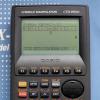Here is a graphical simulation in 2D of the Niels Bohr atomic model, basically the electrons moving around the nucleous in its correct position (obiously on scale)

Is programmed in Casio Basic 2, so it will work in a lot of calculators (That use the second version of Casio Basic) like fx: 7400G, 7400GII, 9750G, 9750G Plus, 9750GII, CFX series, 9860G, 9860GII.
It is only tested on fx-9750GII without upgrade.
It may be useful for didactic pruposes.
20→C 5→R R*2²→S PxlOn 32,64 PxlOn 33,64 PxlOn 32,63 PxlOn 33,63 Lbl 1 For C→J To 360 Step C :For 0→K To 1 R*cos (J+180K)→X R*sin (J+180K)→Y Intg X→X Intg Y→Y PxlOn 32-Y,64+X Next For 0→K To 1 R*cos (J+180K-C)→A R*sin (J+180K-C)→B Intg A→A Intg B→B PxlOff 32-B,64+A Next For 0→K To 5 S*cos (J+60K)→X S*sin (J+60K)→Y Intg X→X Intg Y→Y PxlOn 32-Y,64+X Next For 0→K To 5 S*cos (J+60K-C)→A S*sin (J+60K-C)→B Intg A→A Intg B→B PxlOff 32-B,64+A Next Next Goto 1
Edit reason: put image
Edited by frankmar98, 26 June 2016 - 02:30 PM.






